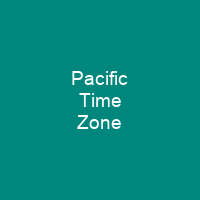The Pacific Time Zone: A Closer Look
Imagine a vast expanse where the sun sets earlier than in other parts of North America – that’s the essence of the Pacific Time Zone (PT). This time zone, which stretches from western Canada to parts of Mexico, is more than just a collection of cities and states; it’s a unique slice of geography with its own quirks and challenges. Have you ever wondered how this zone fits into the broader picture of North American timekeeping?
Standard Time vs. Daylight Saving Time
In the United States and Canada, the Pacific Time Zone is known as Pacific Standard Time (PST) during standard time and Pacific Daylight Time (PDT) when daylight saving time kicks in. This shift isn’t just a change on your watch; it’s a significant adjustment for businesses, schools, and individuals who live or work within this zone.
The Northwest Zone: Mexico’s Perspective
Mexico also has its own version of the Pacific Time Zone called Zona Noroeste (Northwest Zone). This region, which includes Baja California, follows a similar daylight saving schedule. It’s fascinating to see how neighboring countries can have such distinct yet interconnected time zones.
Key Cities and States
The largest city in the Pacific Time Zone is Los Angeles, whose metropolitan area is the largest in the region. Can you imagine the bustling life that goes on there, all under a different clock than much of the rest of North America? Other notable states fully or partially within this zone include California and Washington, with Alaska also sharing parts of it.
Time Zone Splitting: A Canadian Perspective
In Canada, British Columbia is split between the Pacific Time Zone and Mountain Time Zone. Interestingly, Yukon officially switched to a new time zone ‘seven hours behind Coordinated Universal Time (UTC−7)’ after deciding to stop observing daylight saving time. This decision highlights how flexible time zones can be when local needs change.
Time Zones and Broadcasting
The effects of time zones on North American broadcasting are significant. Imagine trying to schedule a live broadcast that spans multiple time zones – it’s like coordinating a global event, but with the added complexity of daylight saving changes! This is why understanding the intricacies of each zone is crucial for media producers and broadcasters.
Proposals for Change
Since 2006, the local time in the Pacific Time Zone has shifted to the second Sunday in March and reversed on the first Sunday in November. However, proposals to abolish bi-annual time changes and adopt year-round standard or daylight time have gained popularity among US states. These discussions reflect a broader debate about the practicality of our current time zone system.
Conclusion
The Pacific Time Zone is more than just a collection of cities and states; it’s a dynamic region that plays a crucial role in North American life. From its unique split between Canada and Mexico to its impact on broadcasting, the PTZ is a fascinating subject that continues to evolve with changing needs and technologies. As we navigate through these changes, one thing remains clear: time zones are not just about clocks; they’re about how we organize our lives.

You want to know more about Pacific Time Zone?
This page is based on the article Pacific Time Zone published in Wikipedia (retrieved on November 29, 2024) and was automatically summarized using artificial intelligence.







